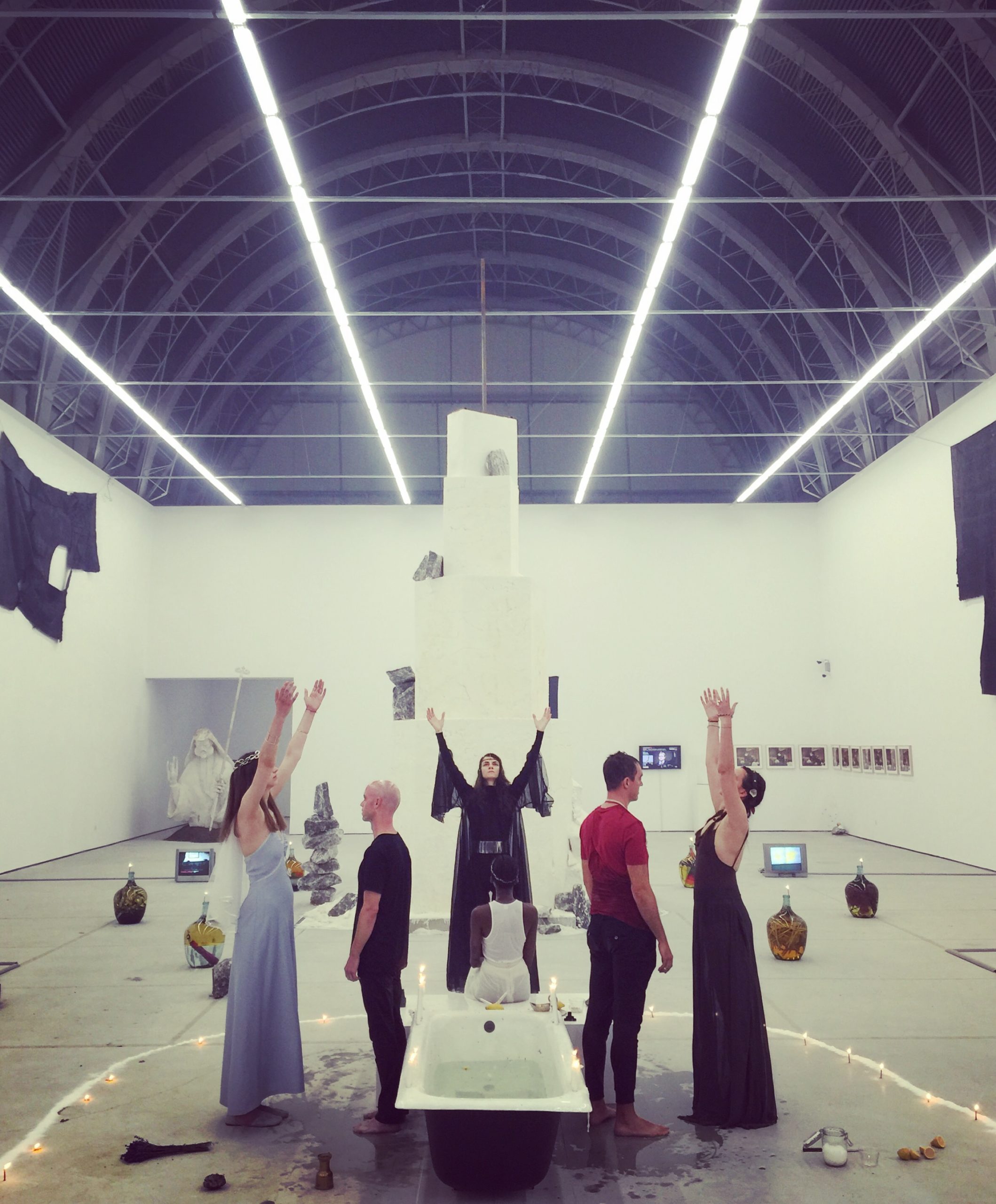“When people discover Alejandro Jodoroswky, there’s like a before-and-after kind of thing,” said curator Aaron Moulton, smoking a cigarette on the deck of his home in LA’s Mount Washington neighborhood, where he lives with his wife Mette and their two children. It was The Holy Mountain, Jodorowsky’s 1973 cult classic film, that introduced Moulton to the filmmaker, artist, and mystic’s “psychomagical” oeuvre. He took from the hallucinatory allegory a thematic blueprint that he has examined extensively in his curatorial work—from exhibitions about Scientology and kundalini energy, to a trilogy focused on the themes of evil, light, and the hierophant.
Recently, Moulton helped facilitate a much-anticipated Los Angeles visit from Jodorowsky and his wife, Pascale Montandon-Jodorowsky, for an exhibition of the collaborative art they create under the name pascALEjandro, at Blum & Poe. Alchemical Love was originally planned for Venus Gallery in Boyle Heights, where Moulton was Creative Director, but he and Venus parted ways last September over creative differences. He instinctively reached out to Blum & Poe, he told GARAGE, because “the gallery has a clear alignment with practices connected to esoterica and spirituality.”
Raised in Midwestern Illinois, Moulton graduated from Seton Hall University in 2000 and received a masters in curating from the Royal College of Art in London in 2005. He then spent four years in Berlin questioning systems and secrets as founder of the Feinkost Gallery, but didn’t begin to explore the connection between art and religion in earnest until he moved to Salt Lake City, where he was senior curator at the Utah Museum of Contemporary Art from 2012 to 2013. There he began to work with Jason Metcalf, an artist and former Mormon whose practice is informed by, according to Moulton, “a perfect cocktail of religion, spirituality, folklore, superstition, anthropology and contemporary art.” For Metcalf’s 2012 solo show at UMOCA, Abracadabra, he created a library of objects associated with superstition, from a jar of pennies to a pile of salt, toying with notions of magic and belief. When he relocated to LA, Moulton continued to work with Metcalf, who now goes by the name Lazaros.
With CLEAR, his first Gagosian Beverly Hills show in 2014, Moulton took the revered Light and Space movement as a starting point, exploring potential aesthetic links to Scientology and astral projection. Luminous works by James Turrell and Larry Bell sat beside contemporary counterparts including Olafur Eliasson; Lazaros made a silver cord sculpture that wound through the gallery, representing the tether that supposedly keeps the soul connected to the body during astral projection. And per Moulton, the show’s Easter egg was a vividly colorful painting by Ingo Swann, who, in addition to being an artist, was also a psychic who developed the practice of remote viewing, and worked with the CIA on several secret surveillance projects.
This was the climate into which Moulton brought his Trito Ursitori (three spirits) trilogy of exhibitions at Nicodim Gallery in Bucharest, Romania, and Los Angeles, which concluded in the summer of 2017. The first was Omul Negru—Romanian for “man in black”—featuring incarnations of the “boogeyman” by 40 artists, installed in an art nouveau palace. But the show wasn’t only meant to spook; it was meant to summon. “I didn’t want it to be about evil,” recalled Moulton, darkly. “I wanted it to be evil itself.”
Before they hung John Wayne Gacy’s clown self-portrait, Sterling Ruby’s vampire fangs, Brian Butler’s occult floor diagrams, or Richard Serra’s Abu Ghraib drawing, Moulton and crew built a Satanic altar inside a wall of the castle—which involved the sacrifice of a baby goat. By his account, this ritualistic death was meted out with care: the farmer who provided the animal was paid, and his family kept the meat, while the heart and hooves were harvested for the altar, and the blood was used to paint the name of the exhibition on a wall. But the act still raises some ethical questions, and provides no simple answers.
If a person doesn’t operate within a Judeo-Christian belief system, does Satan have any power anyway? When Moulton contacted Jodorowsky about including pascALEjandro in the final show of the trilogy, The Hierophant, his hero confessed that he wondered if Moulton was, in fact, evil. The curator’s response? “Awesome! I think that’s a good place to be.” Moulton argued that evil is merely “a way that we’ve bureaucratized nature. I think we’re naturally inclined to fuck and murder and take what thou wilt, I think that’s just a human impulse. And we’ve done everything to repress that through societal norms and civilized order and through this promise of light which is totally unattainable.”
Of course, that didn’t stop him from devoting the next exhibition in the cycle, The Basilisk, to the pursuit of light. Held at Nicodim’s Boyle Heights outpost, perhaps more appropriate for its “LA” theme, the opening was celebrated with the burning of a wheel and the release of 33 white doves from a homemade spaceship by the Unarius Academy of Science, a Southern California group that promotes interdimensional healing through art. Ceremonial Unarius garb was displayed alongside celestial works by Lita Albuquerque and Mungo Thomson, and the Los Angeles Times proclaimed it both “wonderfully jarring” and “cynical.”
“The art world is this last and final green zone for madness in civilization,” Moulton asserted. “If it can adapt and be seen in a new way then it is important.”



